Constraints on Agriculture Production in South Asia: Role of International Collaborative Research
JIRCAS international symposium series
| ISSN | 13406108 |
|---|---|
| 書誌レコードID(総合目録DB) | AA1100908X |

本文フルテキスト
intlsymp-12_89-96.pdf944.02 KB
There are a number of developments in agriculture in South Asia that deserve attention as we move through the new millennium. These are influencing the direction, strategies, and priorities for development at national and international levels. This paper addresses important constraints faced in South Asian agricultural production (biotic and technological), relating to both supply- and demand-driven factors. These issues include the pervasiveness of poverty, continuing concerns about malnutrition, growing constraints on water, lack of technology uptake, and sources of cereal production growth, among others. First, regarding the pervasiveness of poverty, an estimated 560 million poor people now live in South Asia. Some 70% of these 560 million live in rural areas; and poverty will remain predominantly a rural phenomenon until 2030. Governments and international R & D agencies now place high priority on reducing poverty, with South Asia as a focal point. Second, there are continuing concerns about malnutrition in spite of improvements in overall food intakes per capita. Child malnutrition in South Asia is expected to remain a seemingly intractable problem towards 2020. Third, water has become an overarching concern in the region. The rate of expansion of irrigation in India, as in other South Asian countries, has slowed down in recent years due to the increased cost of large-scale canal schemes, reduction in groundwater availability, increased salinity, and the lack of suitable sites for further dams. Projections are that South Asia will be among the regions with the most severe water shortages towards 2025. The growing economic value of water will impose a strain not only within the agricultural sector, but also between agriculture, industry and the cities as competition for limited water supplies grows more intense. R & D will need to emphasize drought and improved water use efficiencies, including water harvesting, as a priority research area. An additional constraint is related to sources of future cereal production growth. Cereal production in South Asia is projected to grow by around 1.5 % per annum to 2020. This is much less than historical growth rates. Additional influencing factors include: changes in the consumption and production trends and the effect of further economic liberalization.
The opportunities for international collaborative research and the role of various research institutes in the global agricultural research system are summarized in three prime roles: the catalyst role of advanced research and international research institutes in basic and strategic research; the bridge and broker roles in the process of dissemination and adaptation of technologies and new research findings; and the adaptive and commercialization roles by developing countries with partnerships of both public and private sectors. The paper discusses examples whereby international centers are functioning as an extremely valuable bridge, broker and catalyst, taking the case of ICRISAT for agricultural research in drought-prone areas of the semi-arid tropics.
The opportunities for international collaborative research and the role of various research institutes in the global agricultural research system are summarized in three prime roles: the catalyst role of advanced research and international research institutes in basic and strategic research; the bridge and broker roles in the process of dissemination and adaptation of technologies and new research findings; and the adaptive and commercialization roles by developing countries with partnerships of both public and private sectors. The paper discusses examples whereby international centers are functioning as an extremely valuable bridge, broker and catalyst, taking the case of ICRISAT for agricultural research in drought-prone areas of the semi-arid tropics.
| 作成者 | M. C. S. Bantilan R. Padmaja |
|---|---|
| 公開者 | Japan International Research Center for Agricultural Sciences |
| オンライン掲載日 | |
| 号 | 12 |
| 開始ページ | 89 |
| 終了ページ | 96 |
| 言語 | eng |
